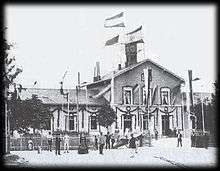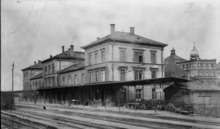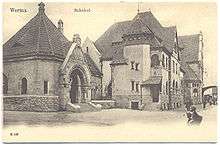Worms Hauptbahnhof
Worms Hauptbahnhof is, along with Worms Pfeddersheim station, one of two operational passenger stations in the Rhenish Hesse city of Worms, Germany. The station with its pedestrian underpass is also an essential link between the eastern and the western parts of central Worms. Every day it is used by about 15,000 people.
Worms station from the east | |||||||||||||||||||||||||||||||||||||||||
| Location | Bahnhofstr. 7/11,Worms, Rhineland-Palatinate Germany | ||||||||||||||||||||||||||||||||||||||||
| Coordinates | 49°38′5″N 8°21′25″E | ||||||||||||||||||||||||||||||||||||||||
| Line(s) |
| ||||||||||||||||||||||||||||||||||||||||
| Platforms | 8 (1–5, 8, 9, 11) | ||||||||||||||||||||||||||||||||||||||||
| Construction | |||||||||||||||||||||||||||||||||||||||||
| Architect | Fritz Klingholz | ||||||||||||||||||||||||||||||||||||||||
| Architectural style | Romanesque Revival architecture | ||||||||||||||||||||||||||||||||||||||||
| Other information | |||||||||||||||||||||||||||||||||||||||||
| Station code | 6887 | ||||||||||||||||||||||||||||||||||||||||
| DS100 code | FWOR | ||||||||||||||||||||||||||||||||||||||||
| IBNR | 8000257 | ||||||||||||||||||||||||||||||||||||||||
| Category | 2 | ||||||||||||||||||||||||||||||||||||||||
| Website | www.bahnhof.de | ||||||||||||||||||||||||||||||||||||||||
| History | |||||||||||||||||||||||||||||||||||||||||
| Opened | 1904 | ||||||||||||||||||||||||||||||||||||||||
| Traffic | |||||||||||||||||||||||||||||||||||||||||
| Passengers | 10,000 [1] | ||||||||||||||||||||||||||||||||||||||||
| Services | |||||||||||||||||||||||||||||||||||||||||
| |||||||||||||||||||||||||||||||||||||||||
| Location | |||||||||||||||||||||||||||||||||||||||||
 Worms Hauptbahnhof Location in Rhineland-Palatinate  Worms Hauptbahnhof Location in Germany  Worms Hauptbahnhof Location in Europe | |||||||||||||||||||||||||||||||||||||||||
History
Beginnings
The history of the railway to Worm began in 1836, when the governments of France and Bavaria were planning to build a railway along the western bank of the Rhine between Basel and Cologne via Strasbourg and Mainz. Two years later, however, the plans were dropped for economic and military reasons by the other states the railway would have crossed: the Grand Duchies of Baden, Hesse and the Kingdom of Prussia. Instead, the Main-Neckar line was built on the east side of Rhine. Finally, in 1844 some citizens in Mainz and Worms took the initiative to establish a company for building a railway from Mainz to Worms. The private company constructing and later operating it was called the Hessian Ludwig Railway (German: Hessische Ludwigsbahn). Several factors such as the lean years of 1846 and 1847, the democratic uprising in 1848-1850 prolonged the opening of the line from Mainz to Worms until 1853.
The first station

There were discussions for six years in Worms on the location of the new station. The Worms council pressed for a central location near the Rhine port, near the present Rheintorplatz, but on 21 September 1852 the Hessian Ludwig Railway chose a site near the cemetery, now Albert-Schulte Park. On 24 August 1853 the line was opened from Mainz to Worms and three months later, on 15 November, the line was extended to Ludwigshafen.
After an initial underestimation of freight traffic, extra facilities were built at Worms station in the following years: a loading dock, a goods shed and a marshalling yard. Now there were regular freight trains conveying sugar beet, grain, coal and much else to the factories, mills and ports in Worms. Following the opening of the railway there was great growth in industry and population in Worms: in 1849 there were only 89 factory workers; in 1858, there were over 2,000.
The second station

With the growth of passenger traffic, the old station buildings were inadequate. In 1871 the old station building was replaced. The new station building was built in the then fashionable neo-classical style. The arrivals hall had a glazed vestibule and first, second and third class waiting rooms, as well as a royal waiting room. Moreover, there was now sleeping quarters for the station manager, meeting rooms and offices for the railway.
With the construction of new railway lines the Worms station again became inadequate. It had only three platforms, squeezed between Bahnhofstrasse and the goods shed.
The third station

)%2C_1971.jpg)
In 1890 the Worms town council called for the station's reconstruction or a new station complex. Following considerable discussion on a new site for the station it was decided, however, to build a new station building on the site of the old station building. The new station now had ten tracks, half of them through tracks from Ludwigshafen and Kaiserslautern to Mainz and Frankfurt am Main.
After about two and a half years of construction, the new station building and platforms was officially inaugurated on 31 March 1904. The approximately 110 metre-long front side of the station building on Bahnhofstrasse was dominated by its entrance hall, which was next to baggage handling facilities and administration offices. On the left side of the entrance hall were the third and fourth-class waiting rooms, in front of a dining room with a bar room; behind it was a corridor, which connected to the first and second class waiting rooms and the stationmaster accommodation. At the left end of the new station building there was also a pavilion for royal travellers.
Approximately 35 years later, at the end of the Second World War, great damage had been done to Worms station: as a result of an air raid on 18 March 1945, all tracks and the interlockings as well as the operations yard, with its rectangular shed, roundhouse and workshops, and the freight yard were completely destroyed. Furthermore, the station building was badly damaged. Subsequently, it took until mid-1945 before trains ran regularly again. Nevertheless, until the end of 1945, 38 of the 53 km of railway tracks in Worms station were still impassable, so that there were still time no operations to Mainz. Only after the founding of the Federal Republic of Germany in 1950, did rail operations in Worms return to normal.
Operations
Long distance
The major services are:
| Line | Route | Interval |
|---|---|---|
| ICE 11 | Wiesbaden – Mainz – Worms – Mannheim – Stuttgart – Ulm – Munich | One train per day |
| IC/EC 32 | Münster (to Klagenfurt) or Dortmund (from Klagenfurt) – Duisburg – Cologne – Koblenz – Mainz – Worms – Mannheim – Stuttgart – Munich – Klagenfurt | Two train pairs |
| IC/EC 35 | Leer (Ostfriesland) – Münster – Recklinghausen – Gelsenkirchen – Duisburg – Cologne – Koblenz – Mainz – Worms – Mannheim – Stuttgart (to Leer) or – Karlsruhe – Konstanz (from Leer) | Two trains pairs |
Regional
The following regional services run:
| Line | Route | Interval |
|---|---|---|
| RE 4 | Mainz – Worms – Frankenthal – Ludwigshafen – Speyer – Germersheim – Karlsruhe | two hourly |
| RE 14 | Mainz – Worms – Frankenthal – Ludwigshafen Mitte – Mannheim | two hourly |
| RB 35 | Bingen Stadt – Alzey – Monsheim – Worms | hourly |
| RB 44 | Mainz – Worms – Frankenthal – Ludwigshafen – Mannheim | half-hourly |
| RB 62 | Worms – Biblis (with connection to RE 70 to Frankfurt) | hourly |
| RB 63 | Worms – Bürstadt – Bensheim | hourly |
Sources
References
- Häussler, Ralph. Eisenbahnen in Worms—Von der Ludwigsbahn zum Rheinland-Pfalz-Takt (Railways in Worms—From the Ludwig Railway to the Rhineland-Palatinate regular interval timetable). Edition Schwarz&Weiss. ISBN 3-935651-10-4.
| Wikimedia Commons has media related to Worms Hauptbahnhof. |